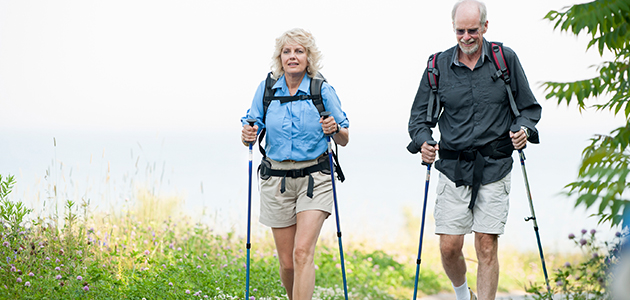If you already love walking and use it as a way to get your recommended 30-minutes per day of aerobic exercise, you might be interested in trying pole walking — also known as Nordic walking.
As the name suggests, pole walking is simply walking with a pair of poles that are similar to those used for skiing. In fact, pole walking began in the early 1990s as a way for cross-country skiers to train during the summer months.1
Watch this quick video for a demonstration of the basic Nordic walking technique. It may look a little different than you think, and there is definitely a “correct” way to use the poles.
You may be wondering, “Why bother with poles? I don’t need any additional support to walk!” But it’s not about support(although using poles can help those recovering from knee or hip surgery). When you walk, you’re using muscles in the lower half of your body. Adding poles to your stride adds upper body muscles to the workout. With Nordic walking poles, your arms, back, shoulders and neck are all engaged.
According to Insideout Physiotherapy & Wellness Group2, you can enjoy the following benefits when you participate in Nordic pole walking:
- Engaging 90% of your body’s muscles, versus just 40% without poles
- Increased cardiovascular workout
- Up to 46% increase in calorie expenditure
- Reduced stress on hips and knees
- Improved posture and balance
- Improved upper body mobility
- Reduced upper back, neck and shoulder pain
Many assume that this is a senior’s exercise, and while Nordic walking is popular amongst that age group, anyone can benefit from adding an upper body workout into their daily walk. If you’ve been considering increasing your physical activity to help protect and improve your heart health, September 29 is World Heart Day — as good a time as any to get started! Pole walking might be right for you.
There may even be a Nordic walking group you can join in your area. Group exercise can help motivate you to get out and increase your social connections within your community. Check your local parks and recreation programs to see if your city or town has any available groups.
For beginners, it’s helpful to watch videos(see above) , and do a little research to make sure you’re getting the most out of your Nordic walking by doing it correctly and safely. For more information on the walking technique and the equipment itself, visit SportMedBC.
As always, talk with your doctor before starting any new exercise routine, particularly if you have any underlying health conditions. Pole walking is a safe and healthy activity recommended by physiotherapists, but every individual is different so it’s always best to err on the side of caution.
SOURCES
417959D CAN/US 09/20




